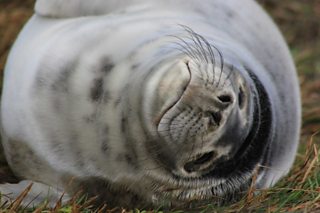Grey seals pups are having to deal with chemicals produced as a result of industry
Dr Kimberley Bennett
Abertay University
White fluffy seal pups are a common sight on Autumnwatch and Winterwatch, it’s the breeding season for UK-based grey seals from September through to December. The pups have a tough time, born during the coldest months of the year on wave-lashed coastlines. They risk being washed out to sea, bitten or crushed by fighting adults or succumbing to infections picked up on the colony. Mum can abandon a pup if she’s scared away or if she simply doesn’t have enough energy to feed it. Many pups don’t make it through the tough weeks ahead.
The cold is the least of their problems. Their fluffy white coat helps keep the pups warm till they have built up enough fat from the rich milk they suckle on. Their ability to gain fat is remarkable: grey seal pups triple their body mass in only three weeks. All that fat gets stored as blubber under their skin. Blubber is not only vital as an insulating blanket, but it also supplies them with metabolic fuel once Mum leaves the colony to feed at sea. Instead of following her once it’s weaned and moulted, the pup sticks around fasting on land, mostly sleeping, for up to a month or more before finally going to sea itself. The blubber has to keep the pup going until it learns to find and catch fish.

So being fat matters for seal pups. They have to get fat fast and then use that fat as insulation and as fuel when fasting. But that lovely fat-rich milk from Mum is laced with chemicals called ‘persistent organic pollutants’ or POPs. POPs are fat soluble and highly stable. They have been banned in Europe and the US since scientists began to realise just how toxic they are.
In the 1970s, scientists noticed marine mammals were experiencing high rates of cancer and skeletal deformities, and in some places failed to reproduce because of high POP levels in their bodies. POP levels in the environment have fallen since the ban, but they remain a problem particularly for marine mammals because POPs are so stable and accumulate in their blubber.
Luckily, we no longer see fertility problems and cancer in UK grey seals. But there may be other lurking dangers.

In humans, there is concern that POPs could contribute to the obesity epidemic by altering the way fat tissue and liver work, making it easier to gain weight and more difficult to lose it. We’re investigating if this also happens in seal pups, which are in the front line because they gain and lose fat so quickly and accumulate POPs rapidly in their first weeks of life. By working with their fat tissue in the lab, we’ve found that some POPs alter the way seal pup blubber works.
Our next step is to find out whether blubber POP levels are high enough to affect how much fat the pups gain when they are suckling, how efficient they are at converting the mothers’ milk into their own body mass, and how fast they lose weight when they are fasting. The biggest problems are likely to occur when food becomes scarce, further away or more spread out, so it takes longer to find. That matters most for seal pups when they first go to sea, because they are naïve and don’t know how or where to catch fish.
Despite POPs, the UK grey seal population is still doing well, but that doesn’t mean we can relax the ban. Our research shows why we need to understand the effects of pollutants and carefully regulate what we’re putting into our oceans. Pollutants can have unexpected and long lasting negative effects on humans and seals alike. That means seals are not only important top predators and a vital part of our marine ecology, so need to be protected, but those beautiful white fluffy pups are also sentinels of ocean and human health.
